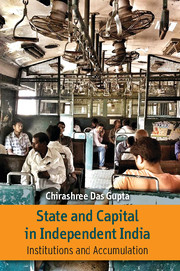Book contents
- Frontmatter
- Dedication
- Contents
- Figures
- Tables
- Acknowledgements
- 1 Introduction
- 2 Globalization and Neoliberalism: The Context and the Debate
- 3 State and Capital in Independent India: The Problematic
- 4 Policy Regimes and Macroeconomic Outcomes: 1947–1966
- 5 Institutionalization of the Regime of Capital in India: 1947–1966
- 6 Continuity and Change in Capital Accumulation: 1966–1980
- 7 Sources of Accumulation: State Intervention and Non-intervention
- 8 ‘Old Oligopolies and New Entrants’ in the Pharmaceutical Sector
- 9 Conclusion
- Bibliography
- Index
5 - Institutionalization of the Regime of Capital in India: 1947–1966
Published online by Cambridge University Press: 05 September 2016
- Frontmatter
- Dedication
- Contents
- Figures
- Tables
- Acknowledgements
- 1 Introduction
- 2 Globalization and Neoliberalism: The Context and the Debate
- 3 State and Capital in Independent India: The Problematic
- 4 Policy Regimes and Macroeconomic Outcomes: 1947–1966
- 5 Institutionalization of the Regime of Capital in India: 1947–1966
- 6 Continuity and Change in Capital Accumulation: 1966–1980
- 7 Sources of Accumulation: State Intervention and Non-intervention
- 8 ‘Old Oligopolies and New Entrants’ in the Pharmaceutical Sector
- 9 Conclusion
- Bibliography
- Index
Summary
Given our argument in Chapter Four that the outcomes of policy regimes in India can be better explained through the characteristic of the institutional structure of the regime of accumulation in India that was installed in this period, we now turn to the alternative perspectives on the Indian transition. Keynesian economics and Marxist political economy has focused on the agrarian constraint traced to the inadequacy of land-reforms and the subsequent wage good constraint and pointed to the crisis of effective or effectual demand as the outcome of this institutional constraint. This perspective starts from institutions (namely agrarian relations) but does not provide a complete explanation of the nature of the accumulation regime installed in India after 1947. This is our point of entry.
In our understanding, the adoption of the Nehruvian vision of building a ‘modern society’ as state ideology and its ‘developmental’ agenda of fostering state-led capitalism lay rooted in the specific context of the formation of the Indian nation-state. The most significant development in the first two decades after independence was the installation of the accumulation regime in India through the selective interventions in institutional arrangements that had emerged in the colonial period. It is these zones of intervention and non-intervention that defined the contradictions in these institutions of accumulation that were evident by the 1960s and culminated in the crisis of 1965–66.
The specificity of the capitalist path in the ‘modernization’ project of the Congress-led state was summed up in three major policy decisions after independence – the decision to protect the sanctity of private property, the use of indicative planning in allocating resources for development (Chibber, 2003) and an assurance of a ‘level playing field for foreign capital’ by Nehru in 1949 in the debates leading to the provisions of non-discrimination against foreign capital in the Companies Act of 1956 (see previous chapter). These were decisions that were upheld by the leadership of the Congress in India and endorsed by leading capitalists involved in the higher echelons of Congress organization and other ‘social organizations’ of capital as we have demonstrated in the earlier chapter. In the preceding chapter, we have also discussed the role of indicative planning and the structure of foreign capital in India.
- Type
- Chapter
- Information
- State and Capital in Independent IndiaInstitutions and Accumulations, pp. 112 - 141Publisher: Cambridge University PressPrint publication year: 2016



